Part 3: Dances of Central and Northern Europe
10 Dances of Northeasten Europe
1. The Baltics
The Baltics (not to be confused with the Balkans!) are the countries that sit on the eastern edge of the Baltic Sea in the north of Europe, and consist of Estonia, Latvia, and Lithuania. They are bordered on the south by Poland and on the east by Belarus and Russia. The Baltic countries have variously been part of the Russian Empire, the Swedish Empire, and the Soviet Union. They are now small but fiercely independent countries. The people who live in Latvia and Lithuania speak languages that are part of the Baltic group of Indo-European languages. The Estonians speak a language related to Finnish and Hungarian, which is unsurprising when you look at a map and see how close Estonia is to Finland.
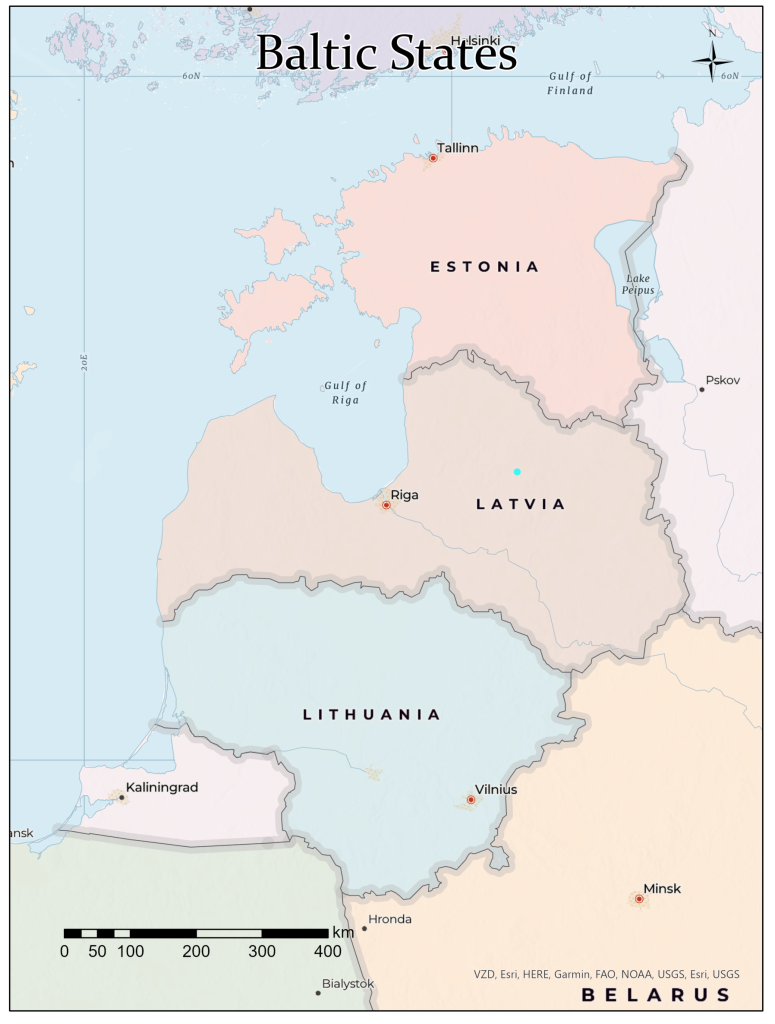
Although there is no linguistic unity among the three Baltic Countries, in terms of costumes, music and dance, they all have a lot in common and, indeed, in common with their Scandinavian neighbors to the north.
Their costumes are characterized by flourishes added using geometrically patterned ribbons, and the costumes also reflect the cold weather climates that these people live in. They wear many layers and clothing covers their bodies fully. Felted jackets and vests are common. The cloth that some clothes are made of is often patterned with checks, plaids, or stripes.
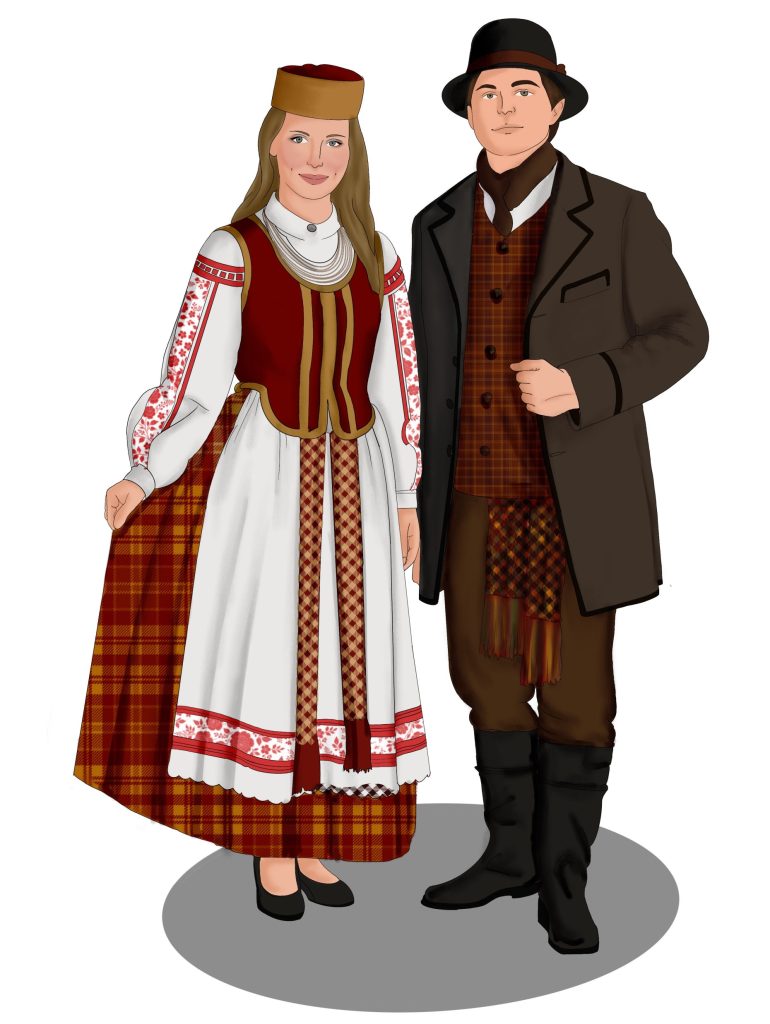
The most characteristic sounding instrument in Baltic music is the Kankles/Kannel/Kokle, which is a plucked zither that sounds a bit like a harpsicord or harp. They also play a small pan flute known as the skudučia, and the haceda, which is a bowed lyre. Of course, you find the standard fare of accordions, jaw harps, bagpipes, and fiddles too.
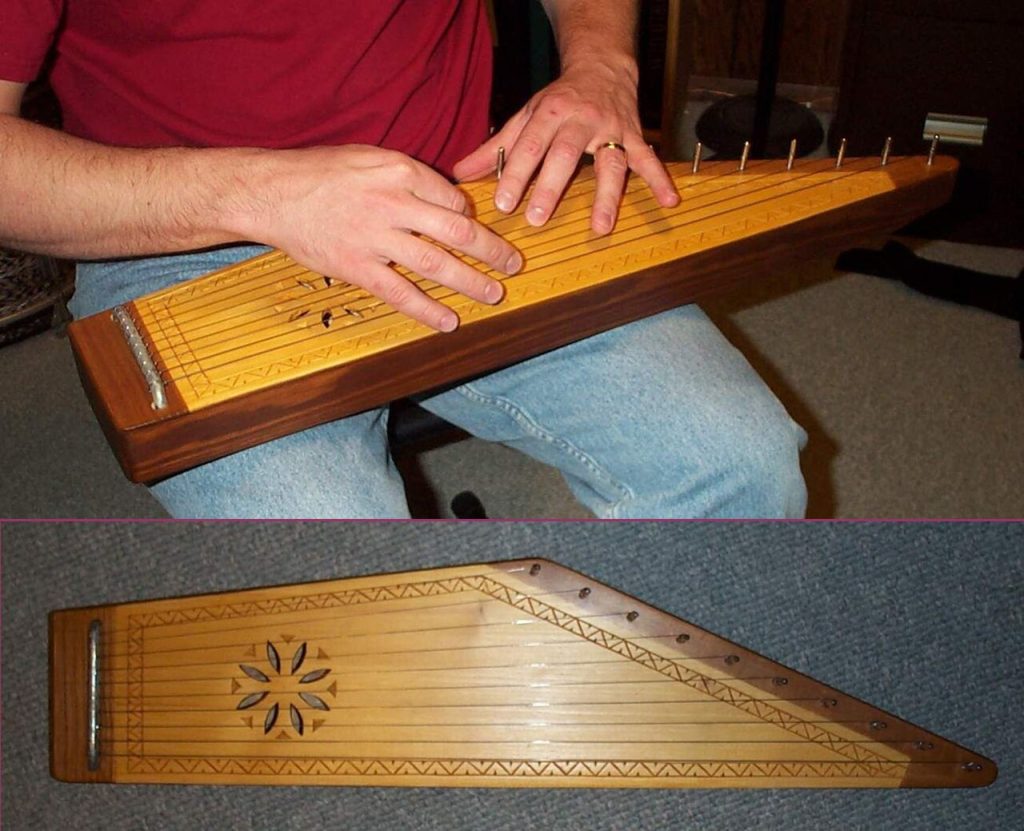

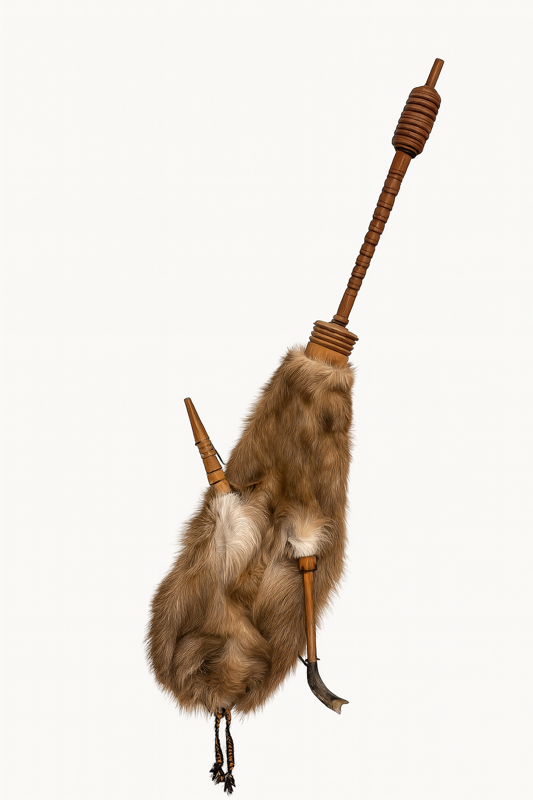
- Lithuanian Kankles: https://youtu.be/XOVjoaGxKt0
- Estonian Kannel: https://youtu.be/80V78SnnC2I
- Latvian Kokle: https://youtu.be/p-99VOCqTcU
- Skudučia: https://www.youtube.com/watch?v=hs738I0QbAQ
In terms of dance, the vast majority of dances from the Baltics are set dances (typically squares) and some couple and trio dances. They use running and walking steps to trace out figures around the dance floor.
- Estonia, Raksi Jaak: https://youtu.be/M5Pxe-AlRU0
- Estonia, Jämaja Labajalg: https://youtu.be/MvcZSn6QLNo
- Latvia, Sudmalina: https://youtu.be/O9gUCR1xMVE
- Lithuania, Jonkelis: https://youtu.be/os-nmIDKDUE
2. Poland
The other countries of Northeastern Europe, Poland, Ukraine, Russia, and Belarus, all speak Slavic languages.
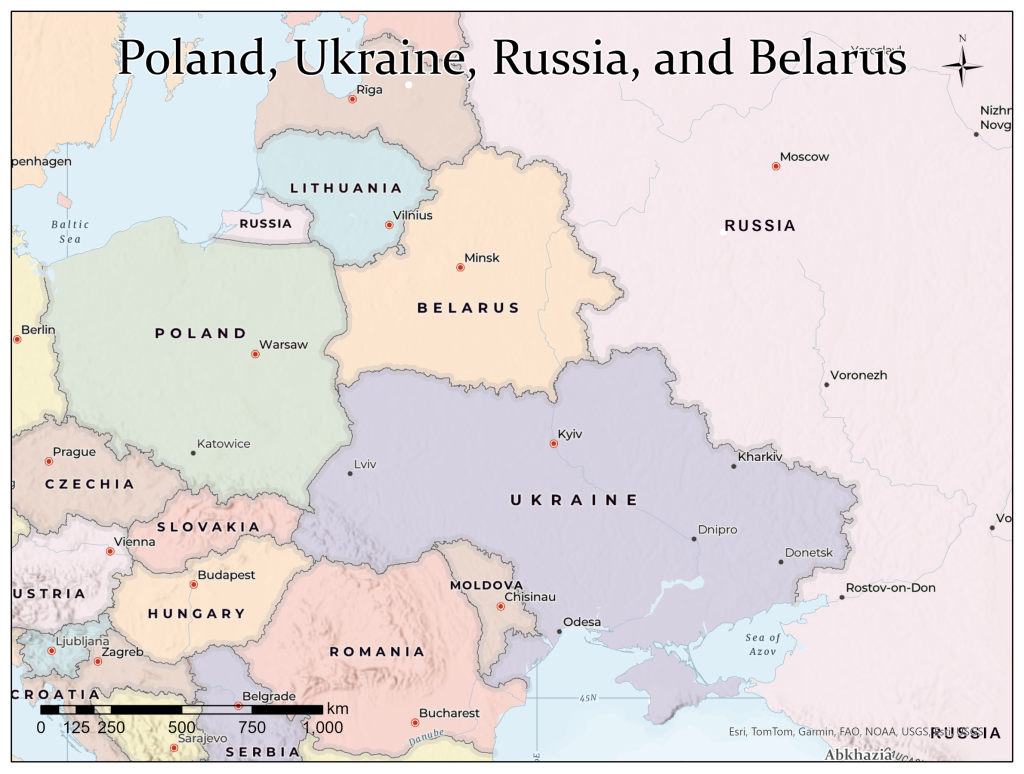
Like many countries we’ve studied, Poland has been occupied and ruled by many countries and empires: the German Hapsburgs, the Prussians, the Russians, and the Nazis. Poland was the site of some of the worst atrocities of the Nazi Genocide. Following WWII, Poland became one of the communist satellite countries until the 1980s, when it was one of the first countries to see open rebellion against its authoritarian regime. A deeply Roman Catholic country is united by a single language, Polish, (there were many German speakers in the region before World War II). Nonetheless, Poland exhibits a diversity of cultural traditions, often linking to those of its neighbors (Germany, The Baltics, Ukraine, Slovakia etc).
There is no single national Polish costume. The people of each region proudly wear the ethnic dress of their own province. That said, common decorations include pompoms and ribbons. Both men and women wear boots to dance. Some examples are below:
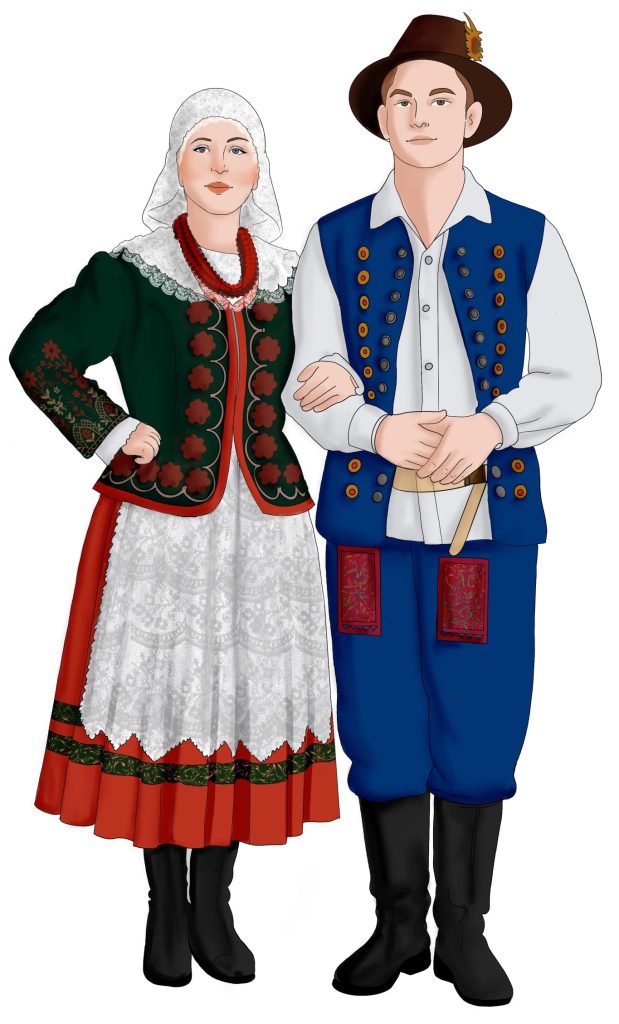
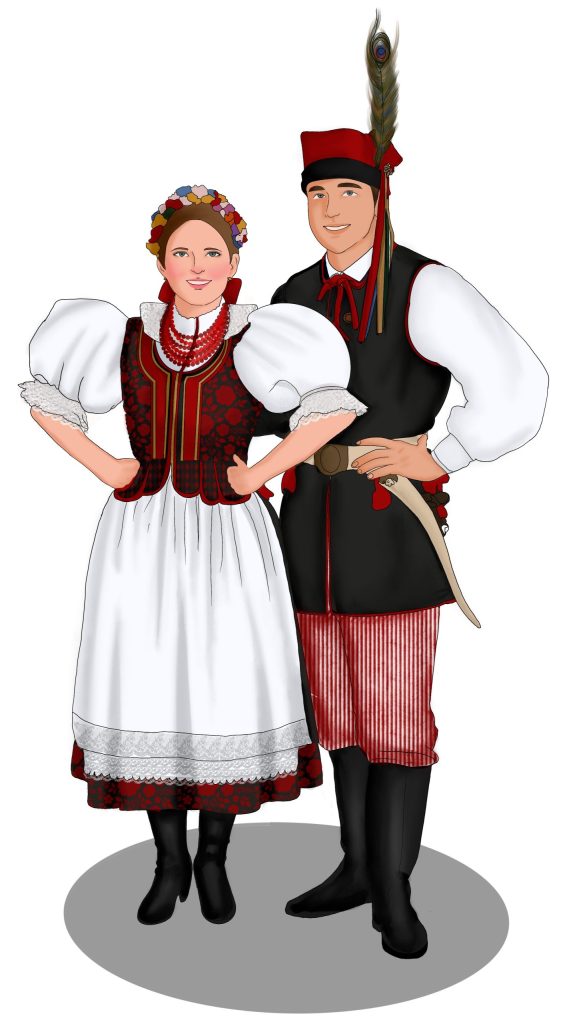
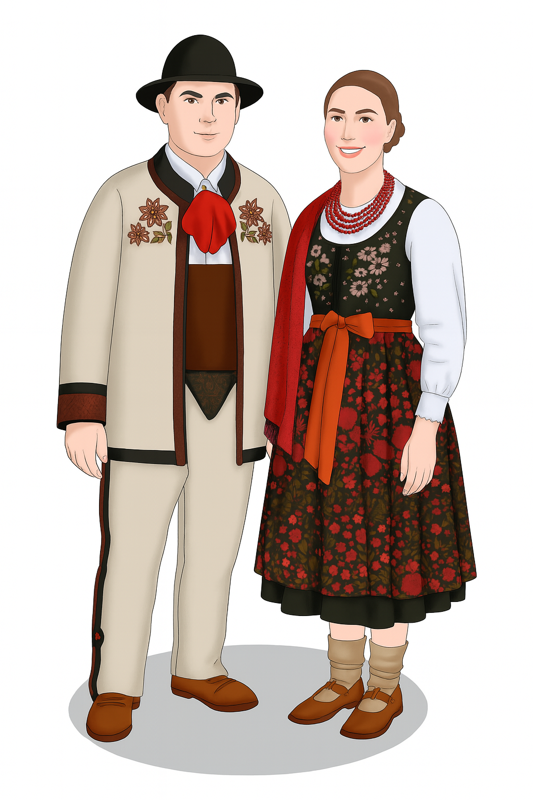
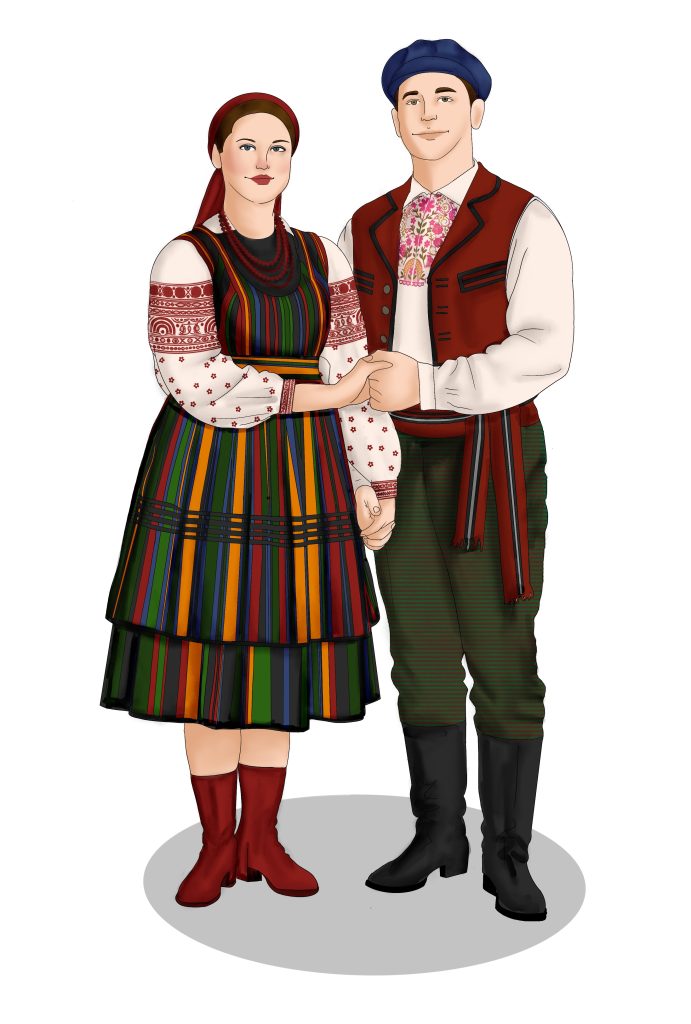
Polish music relies heavily on the violin and accordion, but you also find hurdy-gurdies and hammered dulcimers, bagpipes, zithers, and tambourines.

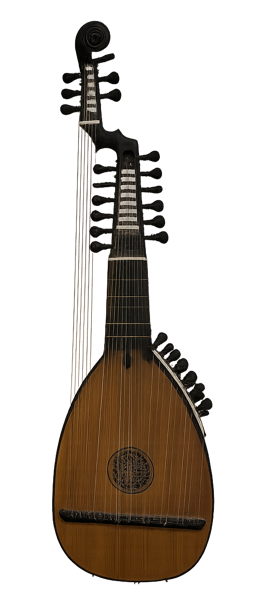
In the history of dance, Poland takes an oversized role. Polish folk dances gave us one version of the Polka (and Polska), the Waltz, the Mazurka, the Polonaise, and other dances widely performed throughout Europe. Western European and American dances borrow so heavily from the Polish folk tradition it is hard to imagine western dancing without these Polish-inspired dance types.
Unlike many countries where there is really only one national style of dance, Poland is characterized by the diversity of its music, costumes, and dances. Every region has its own distinct flavor. Mostly, Polish people dance as couples moving around a circle or square together using turning figures. See the Przeworska (pronounced like P-zhe-vor-ska) as an example of such turning dances. But you will also find circle dances, such as the Goralski axe dance linked below.
- American Polka Dance: https://youtu.be/qZmHe83Im24
- American Polka Dance competition: https://youtu.be/tIfHTXVNoDU
- Ballroom Polonaise: https://youtu.be/o3e1OH1BpjA
- Ballroom Mazurka: https://youtu.be/HPkEyGRRYvs
- Lajkonik from Tucson performing Przeworska in Poland: https://youtu.be/RVN7ES0gfCs
- Goralski axe dance: https://youtu.be/F_BDLYAfg7w
- Krakowiak: https://youtu.be/-5DEujpGqSA
- Kujawiak and Oberek: https://youtu.be/Xv0djIKRMMc
3. Russia, Belarus, and Ukraine
3.1. History and Geography
In terms of landmass, Russia is the largest country in the world spanning 11 times zones and extending from the Baltic Sea in the west to the Pacific Ocean in the east. Ethnically, Russia is dominated by the Rus, who constitute the largest Slavic speaking population in the world. But Russia also includes over one hundred ethnic minorities. Indigenous people of the north, in Siberia and along the Kamchatka Peninsula in the east usually have ethnic connections with the Aleut, and the Yupik and Inupiat Eskimo of Alaska, as well as with the Inuit of Canada. Certain Mongolian groups also live in Russia, and many people of Asia and the former Soviet republics of middle Asia also call Russia home.
Obviously, Russia is still a major world power, and still competes with the USA for influence in the world. Next to Russia, west of Moscow, are two independent nations who assert independent cultures and political authorities: Belarus and Ukraine. At the time of writing this book, Russia and Ukraine are locked in a terrible and brutal war. Even though these are now fiercely independent countries and adversaries, it is hard to discount the close cultural relationship among these three countries linguistically, musically and in dance traditions.
3.2. Music
Iconic instruments of Russian and Ukrainian music include the bandura, which is a large, strummed harp-like instrument; the Balalaika, which is related to the Tambura but is characterized by its distinctive triangular shape; the Garmon, which is a small button accordion, and the Bayan, which is the large orchestral chromatic accordion. The Bayan is called orchestral because it’s an incredibly complex instrument and has a rich sound that almost makes you think multiple instruments are playing.
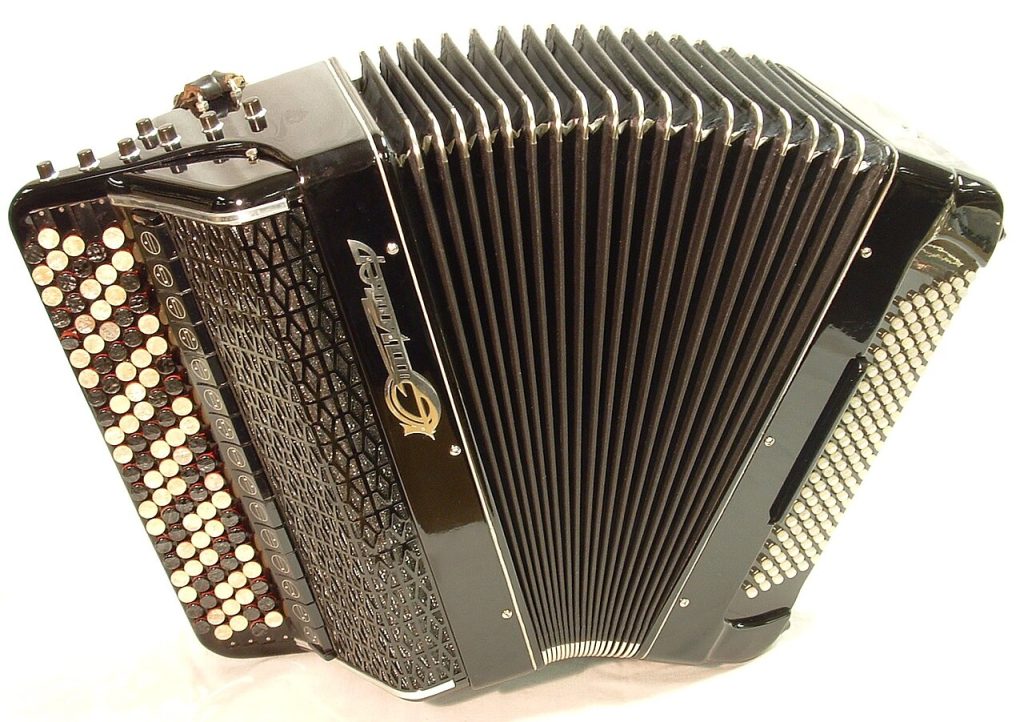
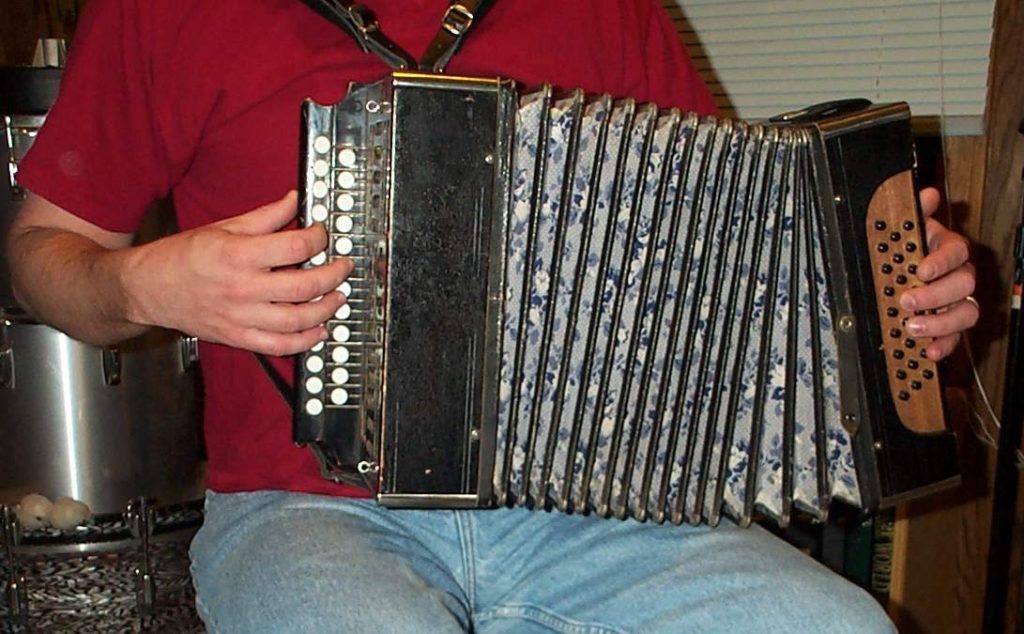
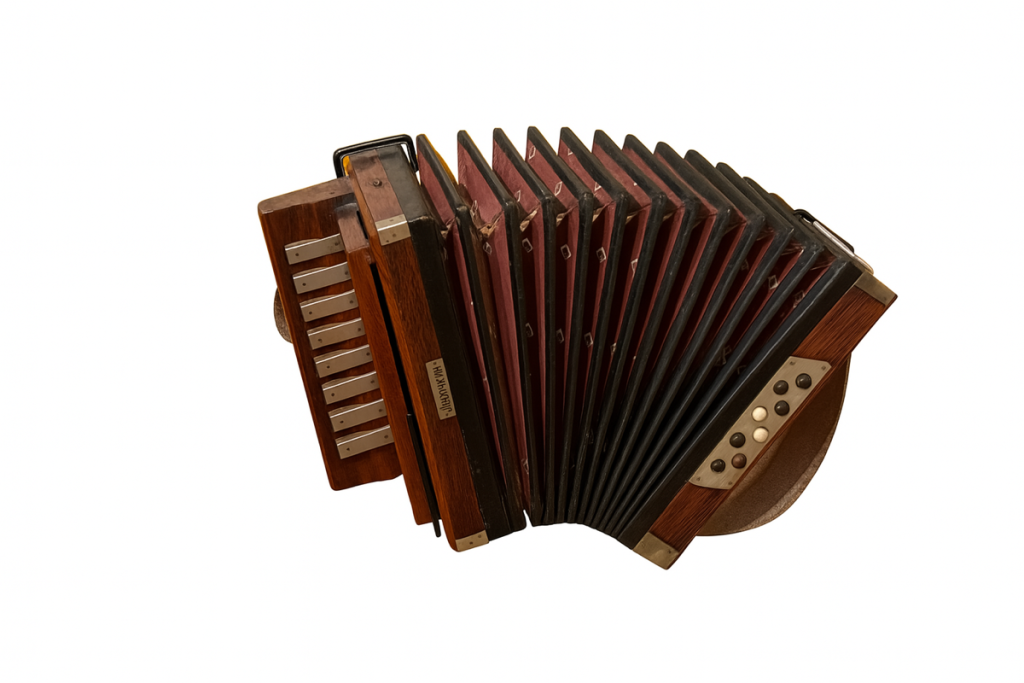
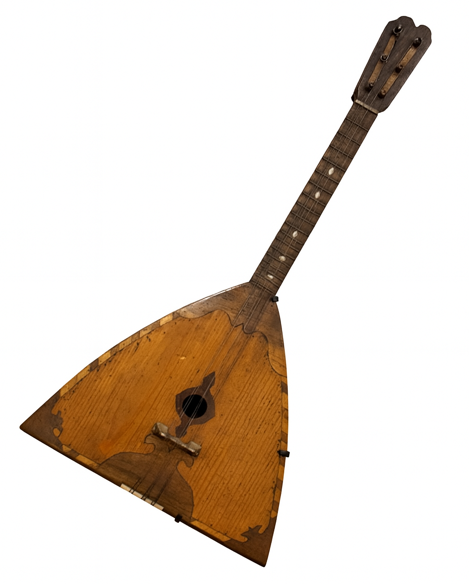
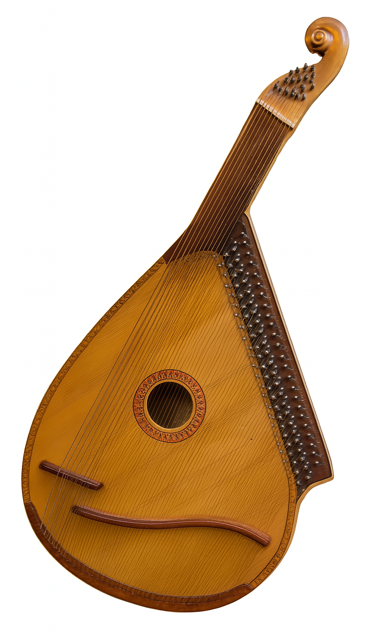
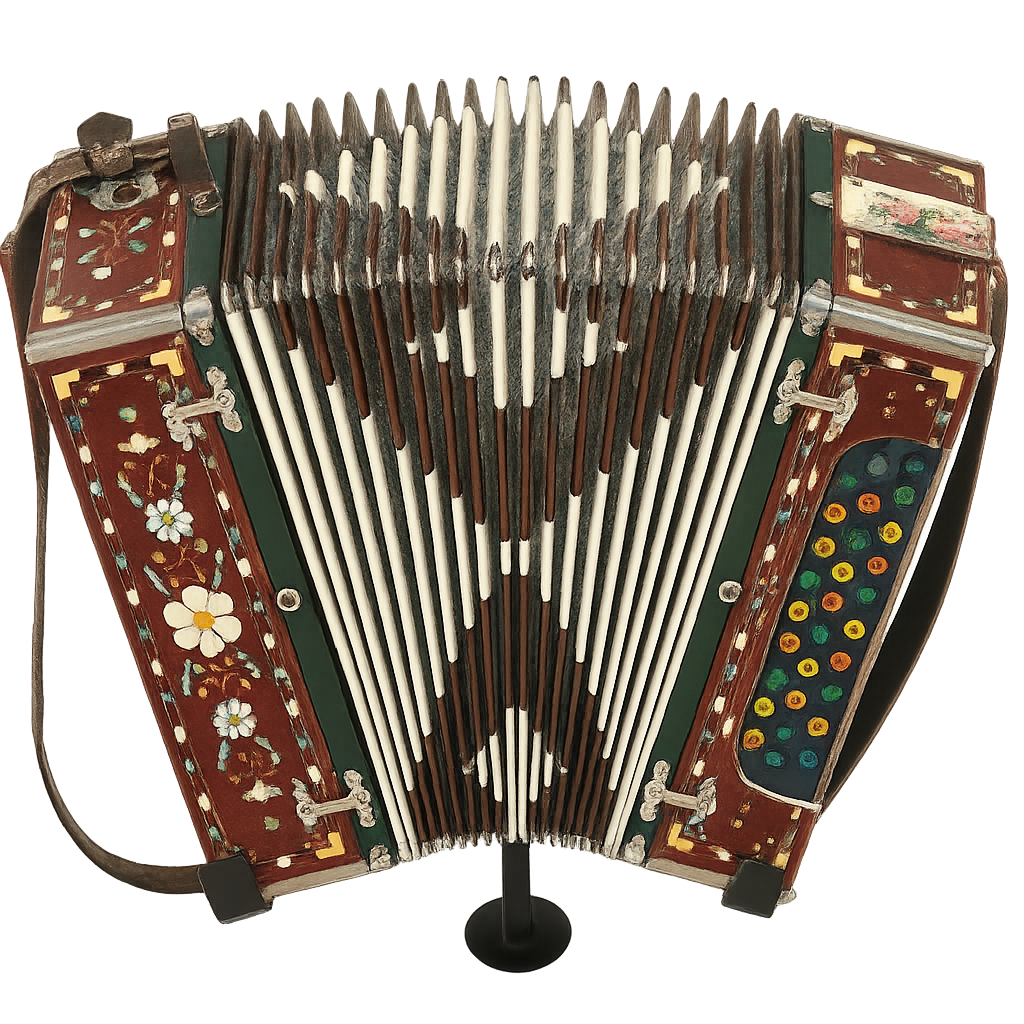
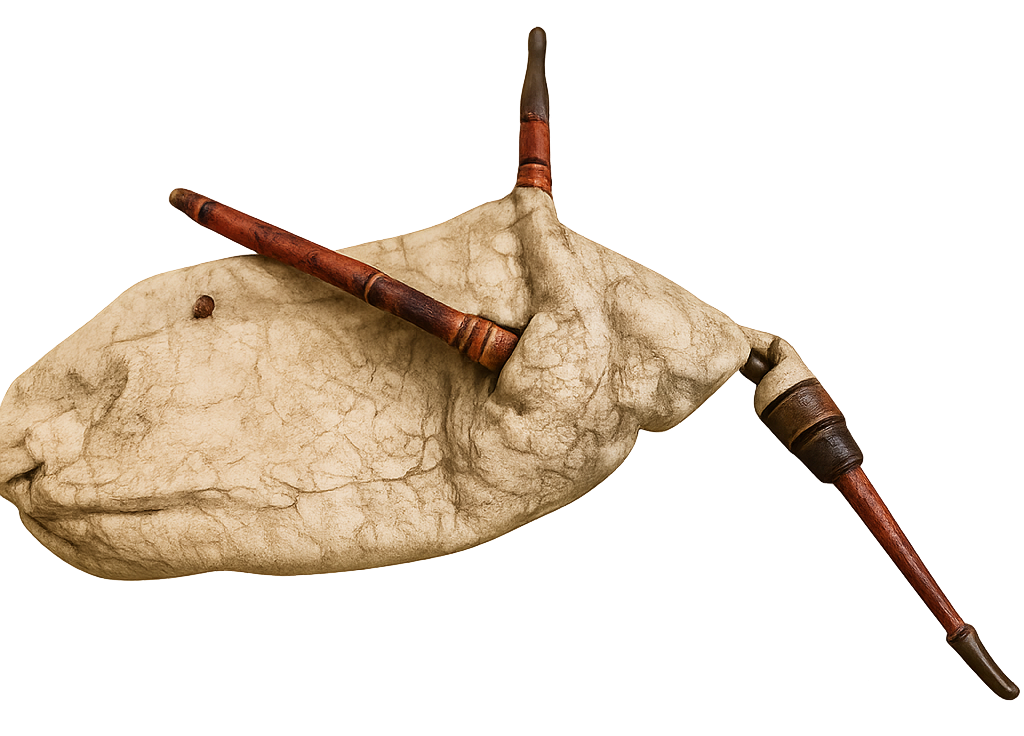

- Bandura: https://youtu.be/dT3P5sGhxpg
- Balalaika Orchestra: https://youtu.be/PFq-6A3lEsY
- Bayan: https://youtu.be/beAN0cqlnIo
3.3. Traditional Dress
Like the traditional costumes of many Slavic nations, Ukrainian and Russian costumes are often heavily embroidered. Boots are the standard for dance footwear. Unmarried Ukrainian women wear elaborate crowns of flowers and ribbons around the head. Russian women wear hats that look like the Pope’s miter. Ukrainian men wear distinctive red or blue satin baggy pants with a cloth belt.
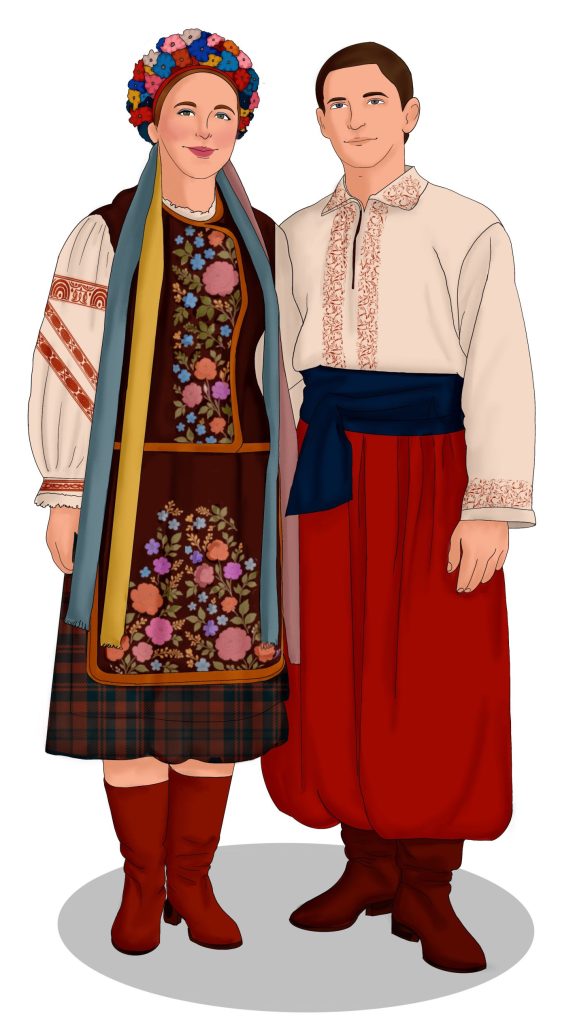

One surprising detail about Russian and Ukrainian dancing is the fact that traditional dances are rarely found today in urban contexts. Very traditional dances are now often only done by families of immigrants and folk dancers in countries like Canada and the USA or at really rural village dance events. What you find as representative of folk dancing in Russia and Ukraine now is almost exclusively elaborate state choreographies. These stage choreographies are usually very spectacular. The men do athletic and showy steps inspired by Cossack dancers, including the Prisyadka squats and kicks. Women typically do floating elegant circle dances called Khorovodnaya, which echo the floating dances of their southern neighbors in Georgia.
In 1936, Igor Moiseyev began the character dance movement in Russia. He choreographed and staged traditional Russian, Ukrainian, and Belarusian folk dances for stage presentation. His dancers had ballet training, so he applied balletic steps and movements to the traditional folk dance forms and patterns. His choreographies included glimpses into folk rituals such as Bread and Salt Welcome ceremonies and solstice celebrations, baptisms, and area wedding festivities. Wedding scenarios always featured an amusing drunken dancer.
Belarusians actually adopted one of Moiseyev’s dances, Bulba (the potato), as a traditional folk dance. This character dance movement, combined with the suppression of most aspects of folk culture during the Stalinist and Soviet years, most likely erased traditional folk dance from these countries. Since the end of the Soviet Union, however, there has been a bit of a “roots” revival in Ukraine and other former Soviet countries where people are looking at doing more traditional, non-stage, dances.
- Russian Berezka Floating dance(Beryoka Ensemble) : https://youtu.be/pQkmqK5U5Uo
- Ukrainian Hopak (Virsky National Ensemble): https://youtu.be/xTnE-yRLg8w
- Belarusian Bulba: https://youtu.be/M-PfjuxW8X4
- Belarusian Vytevskaya Polka: https://youtu.be/M-PfjuxW8X4
- Russian Yablochko (Moisyev Folk Ballet): https://youtu.be/K21yj2lEgrA
- An excellent seminar on traditional dance in Ukraine: https://youtu.be/V6ZhoBuQ5yk
Further Reading
- David (1979); Dziewanowska (1997); Koop (n.d); Marek and Marek (1997); Wolska (1952). See the references section at the end of this book for full citations.
- https://en.wikipedia.org/wiki/History_of_Poland ‘
Some Suggested Dances For Teaching
- Alexandrovska: http://folkdancemusings.blogspot.com/2015/09/alexandrovska-russia.html
- Bielolitsa Kruglolitsa: http://folkdancemusings.blogspot.com/2014/11/bielolitza-kruglolitza-russia.html
- Korobushka: http://folkdancemusings.blogspot.com/2014/06/korobushka-russia.html
- Vesyolayla Quadrille: http://folkdancemusings.blogspot.com/2016/11/vesyolaya-kadril-russia.html
- Sasha: http://folkdancemusings.blogspot.com/2011/10/sasha-russia.html
- Syp Simeon: http://folkdancemusings.blogspot.com/2008/02/syp-simeon-russian-maybe-dutch.html
- Troika: http://folkdancemusings.blogspot.com/2014/07/troika-russia.html
- Arkan: https://folkdancemusings.blogspot.com/2022/11/arkan-kotansky-village-version-ukraine.html
- Klapok: http://folkdancemusings.blogspot.com/2016/07/klapok-adas-version-poland.html
- Polka Jadownicka: https://folkdancemusings.blogspot.com/2020/03/polka-jadownicka-poland.html
Media Attributions
- Figure 10.1: Map of the Baltic States © John W. W. Powell. used with permission. Additional geospatial sources cited in map
- Figure 10.2: Lithuanian Costumes © Asma. Used with permission
- Figure 10.3: Kankles © Theodore Kloba is licensed under a CC BY-SA (Attribution ShareAlike) license
- Figure 10.4: Kokle, Estonia © Musical Instrument Museum, Phoenix. Used with permission
- Figure 10.5. Dūdas, Latvia © Musical Instrument Museum, Phoenix. Used with Permission
- Figure 10.6: Map of Poland, Belarus, Ukraine and European Russia. © John W. W. Powell. Used with permission. Additional geospatial data cited in map.
- Figure 10.7: Costume from Rzeszow © Asma. Used with permission
- Figure 10.8: Costume from Krakow © Asma. Used with permission
- Figure 10.9: Goralski costumes © Asma, used with permission
- Figure 10.10: Opoczno Costumes © Asma. Used with permission
- Figure 10.11: Dudy © Musical Instrument Museum, Phoenix. Used with permission
- Figure 10.12: Torban © Musical Instrument Museum, Phoenix. Used with permission.
- Figure 10.13: Bayan © Henry Doktorski is licensed under a CC BY-SA (Attribution ShareAlike) license
- Figure 10.14: Garmon © Theodore Kloba is licensed under a CC BY-SA (Attribution ShareAlike) license
- Figure 10.15: Buzika, Ukraine © Musical Instrument Museum, Phoenix. Used with permission.
- Figure 10.16: Balalaika © Musical Instrument Museum, Phoenix. Used with permission.
- Figure 10.17: Bandura, Ukraine © Musical Instrument Museum, Phoenix. Used with permission.
- Figure 10.18: Harmoschka, Ukraine © Musical Instrument Museum, Phoenix. Used with permission
- Figure 10.19: Duda, Ukraine © Musical Instrument Museum, Phoenix. Used with permission
- Figure 10.20: Lira, Ukraine © Musical Instrument Museum, Phoenix. Used with Permission
- Figure 10.21: Ukrainian Costumes © Asma. Used with permission
- Figure 10.22: Southern Russian Costumes © Asma. Used with permission

